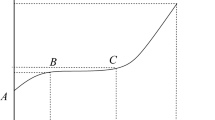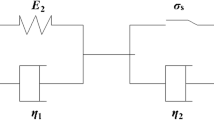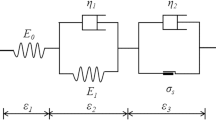Abstract
The MTS815.02 rock test system is used for performing triaxial compression creep experiments on sandstone to reveal the rheological properties of the rock in deep roadways. Instantaneous elastic, viscoelastic, and viscoplastic strains are separated, and the relationship between the model parameters and the stress and time is established by combining the characteristics of the creep curve. According to non-linear rheological theory, the constitutive equation of a creep model of the rock under a three-dimensional stress state is deduced, and the validity of the model is verified by the experimental data. Results show that the improved creep model comprehensively considers instantaneous elastic, non-linear viscoelastic, and viscoplastic strains, making the theoretical curve of the model highly consistent with the experimental curve. The model can describe the non-linear creep during the loading of sandstone. It can also reflect the creep parameters during the deformation. The correlation coefficients of the experimental curve and the theoretical curve under the same stress are both greater than 0.90. The comparison results verify the validity and feasibility of the creep model.
Highlights
-
According to the characteristics of creep curve, the instantaneous strain, viscoelastic strain and viscoplastic strain are separated.
-
The creep model based on viscoelastic-plastic strain separation can well describe the accelerated creep characteristics of rock creep process.
-
The variation of creep parameters also reflects the evolution process of damage accumulation and deterioration of material properties.

















Similar content being viewed by others
Data availability
The datasets used in this study are available upon reasonable request from the corresponding author.
Abbreviations
- σ 1 :
-
Axial stress
- ε e :
-
Instantaneous strain
- K e :
-
Bulk modulus at the instantaneous strain stage
- σ m :
-
Spherical tensor of stress
- a i :
-
Fitting parameter
- c i :
-
Fitting parameter
- σ A :
-
Critical damage stress
- η ve :
-
Viscosity coefficient of the viscoelastic body
- G vei :
-
Shear modulus at any time
- A i :
-
Value of parameter A at any time
- S 11 :
-
Stress tensor
- ε vp :
-
Strain of the Newton’s dashpot
- ε nl :
-
Strain of the non-linear dashpot
- t * :
-
Time to enter the accelerated creep
- σ 3 :
-
Radial stress
- G e :
-
Shear modulus at the instantaneous strain stage
- ε m :
-
Spherical tensor of strain
- ε V :
-
Volumetric strain
- b i :
-
Fitting parameter
- ε :
-
Total creep strain
- ε ve :
-
Viscoelastic strain
- G ve :
-
Shear modulus of the viscoelastic body
- η vei :
-
Viscosity coefficient at any time
- η nl :
-
Viscosity coefficient of the non-linear dashpot
- g(·):
-
A function
- η vp :
-
Viscosity coefficient of the Newton’s dashpot
- t i :
-
Different time point
- σ S :
-
Long-term strength
References
Andargoli MBE, Shahriar K, Ramezanzadeh A, Goshtasbi K (2019) The analysis of dates obtained from long-term creep tests to determine creep coefficients of rock salt. Bull Eng Geol Environ 78(3):1617–1629
Brantut N, Heap MJ, Meredith PG (2013) Time-dependent cracking and brittle creep in crustal rocks: a review. J Struct Geol 52:17–43
Cornet JS, Dabrowski M (2018) Non-linear viscoelastic closure of salt cavities. Rock Mech Rock Eng 51(10):3091–3109
Diisterloh U, Lerche S, Lux KH (2013) Damage and healing properties of rock salt: long-term cyclic loading tests and numerical back analysis//Clean energy systems in the subsurface: production, storage and conversion. Springer, Berlin, pp 341–362
Fan QY, Yang KQ, Wang WM (2010) Study on creep mechanism of muddy soft rock. Chin J Rock Mech Eng 29(8):1555–1561 ((in Chinese))
Findley WN, Lai JS, Onaran K (1976) Creep and relaxation of non-linear viscoelastic materials with an introduction to linear viscoelasticity. North Holland, Amsterdam
Hamza O, Stace R (2018) Creep properties of intact and fractured muddy siltstone. Int J Rock Mech Min Sci 106:109–116
Heap MJ, Baud P, Meredith PG (2009) Time-dependent brittle creep in Darley Dale sandstone. J Geophys Res Solid Earth 114:B07203
Hou RB, Zhang K, Tao J, Xue XR, Chen YL (2019) A non-linear creep damage coupled model for rock considering the effect of initial damage. Rock Mech Rock Eng 52(5):1275–1285
Hu B, Yang SQ, Xu P (2018) A non-linear rheological damage model of hard rock. J Cent South Univ 25(7):1665–1677
Huang M, Liu XR (2011) Study on the relationship between parameters of deterioration creep model of rock under different modeling assumptions//Advanced materials research. Trans Tech Publ Ltd 243:2571–2580
Jin J, Cristescu ND (1998) An elastic/viscoplastic model for instantaneous creep of rock salt. Int J Plast 14(1–3):85–107
Jing W, Zhao Y, Kong J, Huang C, Jilani KM, Li H (2018) The time-space prediction model of surface settlement for above underground gas storage cavern in salt rock based on Gaussian function. J Nat Gas Sci Eng 53:45–54
Li WQ, Li XD, Han B, Shu Y (2007) Recognition of creep model of layer composite rock mass and its application. J Cent South Univ Technol 14(1):329–331
Liu WB, Zhang SG (2021) An improved unsteady creep model based on the time dependent mechanical parameters. Mech Adv Mater Struct 28(17):1838–1848
Liu XX, Li SN, Xu ZP, Li Y, Gao XW, Wang WW (2019) Viscoelastic-plastic creep model of high stress argillaceous siltstone. J Cent South Univ Sci Technol 50(5):1210–1220 ((in Chinese))
Liu XX, Li SN, Zhou YM, Li Y, Wang WW (2020) Study on creep behavior and long-term strength of argillaceous siltstone under high stresses. Chin J Rock Mech Eng 39(1):138–146 ((in Chinese))
Liu WB, Zhou H, Zhang SG, Jiang S, Yang L (2022) A non-linear creep model for surrounding rocks of tunnels based on kinetic energy theorem. J Rock Mech Geotech Eng 55(2):363–374
Ma LJ, Liu XY, Fang Q, Xu HF, Xia HM, Li EB, Li WP (2013) A new elasto-viscoplastic damage model combined with the generalized Hoek-Brown failure criterion for bedded rock salt and its application. Rock Mech Rock Eng 46(1):53–66
Munson DE, Weatherby JR (1993) Two- and three-dimensional calculations of scaled in situ tests using the M-D model of salt creep. Int J Rock Mech Min Sci Geomech Abstr 30(7):1345–1350
Qi YJ, Jiang QH, Wang ZJ (2012) 3D creep constitutive equation of modified Nishihara model and its parameters identification. Chin J Rock Mech Eng 31(2):347–355
Riva F, Agliardi F, Amitrano D, Crosta GB (2018) Damage-based time-dependent modeling of paraglacial to postglacial progressive failure of large rock slopes. J Geophys Res Earth Surf 123(1):124–141
Shen MR, Chen HJ (2011a) Testing study of long-term strength characteristics of red sandstone. Rock Soil Mech 32(11):3301–3305
Singh A, Kumar C, Kannan LG, Rao KS, Ayothiraman R (2018) Estimation of creep parameters of rock salt from uniaxial compression tests. Int J Rock Mech Min Sci 107:243–248
Tang H, Wang D, Huang R, Pei X, Chen W (2018) A new rock creep model based on variable-order fractional derivatives and continuum damage mechanics. Bull Eng Geol Environ 77(1):375–383
Tomanovic Z (2006) Rheological model of soft rock creep based on the tests on marl. Mech Time Dependent Mater 10(2):135–154
Wang J, Liu X, Song Z, Guo J, Zhang Q (2016) A creep constitutive model with variable parameters for thenardite. Environ Earth Sci 75(11):1–12
Wang R, Jiang Y, Yang C, Huang F, Wang Y (2018a) A non-linear creep damage model of layered rock under unloading condition. Math Probl Eng 20:18
Wang X, Yin Y, Wang J, Lian B, Qiu H, Gu T (2018b) A nonstationary parameter model for the sandstone creep tests. Landslides 15(7):1377–1389
Wu F, Liu JF, Wang J (2015) An improved Maxwell creep model for rock based on variable-order fractional derivatives. Environ Earth Sci 73(11):6965–6971
Xu M, Jin D, Song E, Shen D (2018a) A rheological model to simulate the shear creep behavior of rockfills considering the influence of stress states. Acta Geotech 13(6):1313–1327
Xu T, Zhou G, Heap MJ, Yang S, Konietzky H, Baud P (2018b) The modeling of time-dependent deformation and fracturing of brittle rocks under varying confining and pore pressures. Rock Mech Rock Eng 51(10):3241–3263
Xu T (2015) Creep model of brittle rock and its application to rock slope stability. In: International symposium on mega earthquake induced geo-disasters and longterm effects
Yan Y (2009) Research on rock creep tests under seepage flow and variable parameters creep equation, PHD. Tsinghua University, Beijing
Yan Y, Wang SJ, Wang EZ (2010) Creep equation of variable parameters based on Nishihara model. Rock Soil Mech 31(10):3025–3035 ((in Chinese))
Yang L, Li ZD (2018) non-linear variation parameters creep model of rock and parametric inversion. Geotech Geol Eng 36(5):2985–2993
Yang X, Jiang A, Zhang F (2021) Research on creep characteristics and variable parameter-based creep damage constitutive model of gneiss subjected to freeze–thaw cycles. Environ Earth Sci 80(1):1–16
Yoshida H, Horii H (1992) A micromechanics-based model for creep behavior of rock. Appl Mech Rev 45(8):294–303
Yu M, Mao X, Hu X (2016) Shear creep characteristics and constitutive model of limestone. Int J Min Sci Technol 26(3):423–428
Zhang L (2021) Theoretical and experimental research on the evolution of creep-seepage for coal containing gas. China University of Mining and Technology, Beijing ((in Chinese))
Zhang SG, Liu WB, Chen L (2019) Unsteady creep model based on time-dependentness of mechanical parameters. J China Univ Min Technol 48(5):993–1002
Zhao YL, Wang YX, Wang WJ, Wan W, Tang JZ (2017a) Modeling of non-linear rheological behavior of hard rock using triaxial rheological experiment. Int J Rock Mech Min Sci 93:66–75
Zhao YL, Zhang LY, Wang WJ, Wan WW, Li SQ, Ma WH, Wang YX (2017b) Creep behavior of intact and cracked limestone under multi-level loading and unloading cycles. Rock Mech Rock Eng 50(6):1409–1424
Zhao YL, Zhang LY, Wang WJ, Wan WW, Ma WH (2018) Separation of elastoviscoplastic strains of rock and a non-linear creep model. Int J Geomech 18(1):04017129
Zhou W, Chang XL, Zhou CB, Liu XH (2010) Creep analysis of high concrete-faced rockfill dam. Int J Numer Methods Biomed Eng 26(11):1477–1492
Zhou HW, Wang CP, Han BB, Duan ZQ (2011) A creep constitutive model for salt rock based on fractional derivatives. Int J Rock Mech Min Sci 48(1):116–121
Acknowledgements
This work was supported by the National Natural Science Foundation of China (Grant nos. 4206070032 and 41941018), the Science and Technology Service Network Initiative of the Chinese Academy of Sciences (Grant no. KFJSTS-QYZD-174), and the Guangxi Natural Science Foundation (Grant no. 2020GXNSFAA159125).
Author information
Authors and Affiliations
Contributions
WL: conceptualization, data curation, writing—original draft, investigation, and methodology. HZ: conceptualization, writing—original draft, writing—review and editing, software, supervision, and methodology. SZ: conceptualization, data curation, methodology, and investigation. CZ: English grammar correction and language polishing, supervision and writing—review and editing.
Corresponding authors
Ethics declarations
Conflict of interest
The authors declared that they have no conflicts of interest to this work.
Additional information
Publisher's Note
Springer Nature remains neutral with regard to jurisdictional claims in published maps and institutional affiliations.
Rights and permissions
Springer Nature or its licensor (e.g. a society or other partner) holds exclusive rights to this article under a publishing agreement with the author(s) or other rightsholder(s); author self-archiving of the accepted manuscript version of this article is solely governed by the terms of such publishing agreement and applicable law.
About this article
Cite this article
Liu, W., Zhou, H., Zhang, S. et al. Variable Parameter Creep Model Based on the Separation of Viscoelastic and Viscoplastic Deformations. Rock Mech Rock Eng 56, 4629–4645 (2023). https://doi.org/10.1007/s00603-023-03266-7
Received:
Accepted:
Published:
Issue Date:
DOI: https://doi.org/10.1007/s00603-023-03266-7




